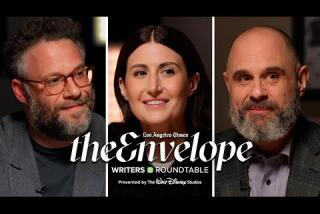How the bright candy colors of ‘Promising Young Woman’ disguise the truth
- Share via
One of the likely reasons “Promising Young Woman” is up for so many Academy Awards — including best picture, director and editor — is because it defies audience expectations at every turn. Emerald Fennell’s directorial debut is a movie about rape culture, but it’s not dreary. It’s a revenge thriller, but it’s not conventionally cathartic. It’s poppy and candy-colored at one turn, savage and scary the next.
Fennell hired French editor Frédéric Thoraval — whose credits include horror films and action thrillers — to help achieve her unique vision of a story about a young woman named Cassie (Oscar-nominated Carey Mulligan) who goes to extremes in response to a society that wants to exploit her or sweep her under the rug. Fennell and Thoraval convened on Zoom to speak with The Envelope.
What took you to Fred’s door for this film?
Emerald Fennell: He’s worked on all sorts of genres — from mega-horror to big action to smaller films. The most recent things on his CV, or the ones that kind of caught my eye as a horror fan, were “Sinister” and “Taken.” It’s hard to make a really taut thriller, and it’s hard to make really scary horror, and both of them were great.
What was your vision for the film, stylistically?
Fennell: I sent everyone a mood board and a playlist. The mood board was 25 pages long, and it was all sorts of things — from costume references to makeup references to shots. It was a combination of “American Psycho,” “To Die For,” “The Virgin Suicides,” some Gregory Crewdson photographs, lots of Cindy Sherman, [Michael] Powell and [Emeric] Pressburger — things that are more arch and allegorical. We all have so many assumptions about the way films look and about the way a serious subject needs to be discussed and shown. I was keen early on to say, “I can anticipate what people think this is going to look like, which is a rainy pane of window, and handheld camera, and a lot of gray. But it’s going to be the opposite of that. It’s going to be incredibly beautiful and feminine and arch — and deliberately made.
Did you want it to be a fun experience to watch this film?
Fennell: I think certainly I wanted it to be appealing. It was important that it wouldn’t preach to the converted, I suppose. Really the most important thing about it, aside from all the political things, was that it was a film that was gripping and romantic and sad. It was important that the film itself mimicked who Cassie is — she’s an expert at using pop femininity and blondness and pink to hide her suffering and also to make herself seem innocuous. One of the things that you rarely see in films is how unbelievably aware women are of how they move through the world and how they can use that, how they can disguise themselves. So it was incredibly important that it felt like something you would want to watch, that it wasn’t medicine.
Are we always experiencing this through Cassie’s perspective?
Frédéric Thoraval: Absolutely. The main thing that we needed to have, from the very beginning of the movie, was an emotional connection with her. As soon as we have that connection as an audience, we could have a bit of her experience, and we could be on that roller coaster where we can have twists and turns. That’s why the performance of Carey was so important, because she was giving us the direction on everything. It was such a pleasure to cut with her, because it was all about nuance and trying to find a way to stay with her as much as we could. I think as soon as we get that, everything can be accepted, and all the turns — the shift, the tonal elements that are changing — were hopefully able to work.
You’re also playing with the audience, in a way. Is she actually murdering her “victims”? Can you talk about some of those shifts and manipulating our expectations?
Fennell: What’s really thrilling is that audiences are so wise now to story beats, they’re so wise to character traits. That was a huge advantage, because not only do you have a really interesting map of beats when it comes to the revenge thriller genre — or, stripping it back even further, to allegorical, biblical tales or a bedtime story where people learn lessons — we all are so familiar with those beats. Just as long as you know what the expectation is, then you can push that as far as it will go before kind of retreating. A good example is the ketchup on the leg. It’s that combination of music, the slow pan up her body, which we’re so used to seeing the blood, and the last thing you see, really, is the hot dog. So you’ve given the audience enough time to be tricked, but it’s not gone on so long that people don’t feel the deliciousness of the surprise.
Can you talk about another shift when Cassie seems to be finding peace and falling in love with Ryan [Bo Burnham]?
Thoraval: We are more in a kind of rom-com feeling. There’s maybe melancholy before, when she’s alone, but when she’s back with him, it’s a kind of fireworks and explosion that you have with the song [“Stars Are Blind”], with that montage, with the good time they are spending together and the life they could have together. We needed that moment to feel, as she’s falling so much for him, the audience has to fall for him as well.
More to Read
Sign up for The Envelope
Get exclusive awards season news, in-depth interviews and columnist Glenn Whipp’s must-read analysis straight to your inbox.
You may occasionally receive promotional content from the Los Angeles Times.






